
Creative writing has been one of the hardest forms of expression since the last century. Doesn’t matter if you’re writing novels, are a poet, or a screenwriter; nearly all writers encounter writer’s block at some point.
Now, AI is changing how we work. Almost 45% of writers now use AI-driven tools in their creative writing process, and they realize they’re able to be more productive while still keeping their own voice.
So we’ve compiled a list of ten best AI tools for creative writing. These aren’t just any generic content generators – they’re platforms specifically built for different creative writing needs like story writing, fiction writing, non-fiction writing, poetry, and more.
Why Use AI for Creative Writing?
Some of the best creative writing is done with a partner who is not afraid to call out bad ideas, propose alternatives you hadn’t thought of, or really make you defend what you’re trying to say.
This is exactly what AI tools can do for you. The creative sparks start to fly when AI tools are used this way.
Got problems giving your villain depth? Wondering what alternatives you could have gone with on the ending? AI can not only forecast but also provide characters’ motivations and narrative ideas, helping you with the testing without wasting time on having to cut out huge sections.
Plus, they work on your schedule. Whenever you like, 6 am or midnight. A line or a whole plot arc. AI tools have got your back when you’re trying to finish or when you are ramming into a writer’s block.
1. For Fiction Writing – Sudowrite

If you’re looking for a tool that can help you expand scenes, develop characters, and maintain story consistency throughout long projects, Sudowrite is your tool. It analyzes your existing story context to provide suggestions that actually fit your narrative world.
What sets Sudowrite apart:
- Context-aware suggestions: Instead of generic personality traits, it analyzes your existing story and offers suggestions that fit your narrative world
- Story Bible feature: Acts like your project’s memory bank, storing character details, plot threads, and world-building elements to maintain consistency
- Sensory enhancement: Transform simple sentences into rich, sensory details that match your story’s tone
- Multiple tools in one: Includes “Rewrite,” “Describe,” and “Write” functions that work with your existing content
Here’s how most writers use it: highlight a section you want to expand or improve, then choose from the available tools. The AI generates suggestions based on your writing style and story context, not cookie-cutter templates.
Sudowrite runs on credits with plans starting around $10 monthly for casual writers, scaling to $25-30 for heavy users. Writers consistently mention how it maintains their voice while pushing creativity in unexpected directions.
The main limitation is that it’s built for fiction, so if you’re working on non-fiction or very experimental forms, other tools might serve you better.
2. For Story Writing – Generate Story
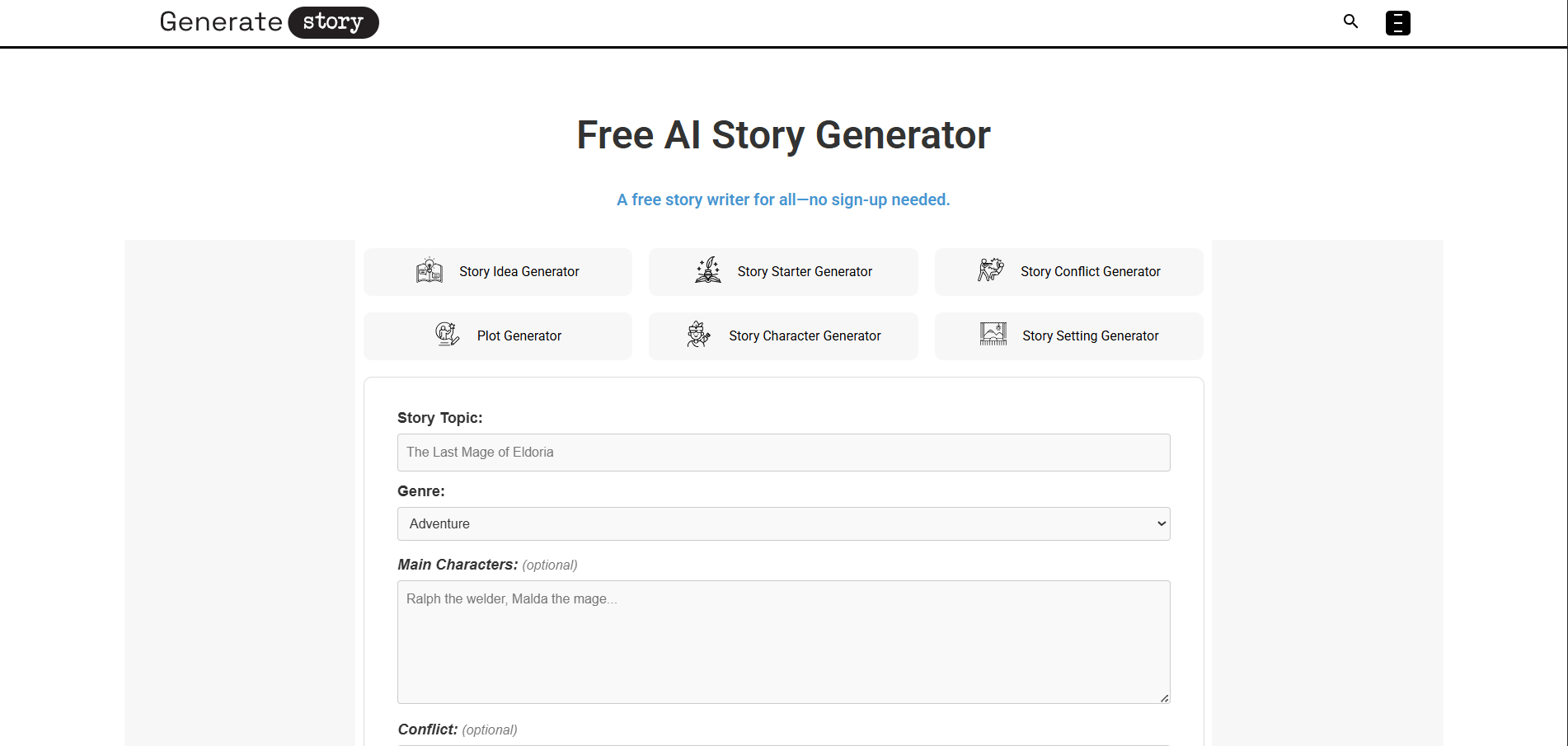
For writers who struggle with plot development and story structure, Generate Story focuses on creating compelling story concepts and detailed plot frameworks. This AI story generator platform is great at generating ideas for plots, characters, conflicts, story starters and more across several genres.
Key features include:
- Genre-specific understanding: Particularly excels in science fiction and fantasy, understanding the unique world-building requirements these genres demand
- Plot framework generation: Input a basic premise and get plot frameworks that consider genre conventions, character archetypes, and narrative structure
- Story extension tools: Develop initial ideas into fuller narrative structures, starting with single scenes and expanding to complete outlines
- Diverse generators: Create plot ideas, plot twists, conflicts, story starters, and character backstories across multiple genres
- Customizable inputs: Choose genre, add character details, story settings, and conflicts to generate exactly what you need
You make the important creative decisions while it handles connecting plot points and suggesting narrative possibilities you might have missed.
Generate Story offers free unlimited access to its core features. While other platforms limit usage through credits or subscriptions, you can experiment with plot ideas without hitting usage caps.
The downside is that generated content often needs significant editing to match your specific vision, and some suggestions can feel generic or overused.
3. For Songwriting – Amadeus Code
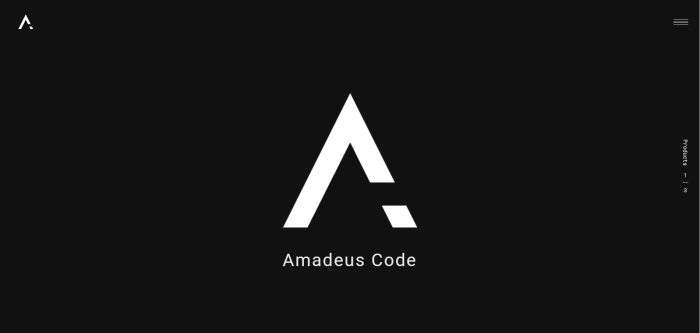
For musicians who want to create songs where lyrics and melody work together seamlessly, Amadeus Code understands both musical structure and lyrical flow. The tool helps you create words that fit naturally with your rhythm and mood.
What Amadeus Code offers:
- Musical intelligence: Creates compositions while helping craft words that fit naturally with rhythm and mood
- Genre awareness: Knows that folk ballad lyrics need different rhythmic patterns than pop anthems
- Structural understanding: Grasps how verses build tension, choruses soar, and bridges provide emotional pivots
- Melody-lyric integration: Suggests rhyme schemes that complement your melody rather than fighting against it
- Collaborative approach: Bridges the gap between musical and lyrical creativity
Songwriters use it in fascinating ways. Start with a chord progression and let Amadeus Code suggest lyrical themes that match the musical emotion. Or begin with a concept – heartbreak after a long relationship – and watch as it helps find both melodic phrases and words that capture that specific feeling.
The platform offers various subscription tiers depending on your output needs and commercial usage requirements. For serious songwriters and composers, the investment opens up creative possibilities that would be difficult to achieve working alone.
4. For Poetry – GeneratePoem.io
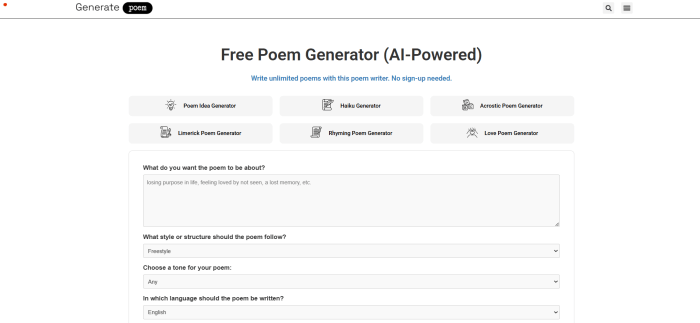
For poets who need help with literary nuances, meter, and emotional expression, GeneratePoem.io understands the complexities of poetic language and form. Whether you’re working on structured sonnets or experimental free verse, it can help refine your work without losing your unique voice.
What makes this special for poets:
- Literary sensibility: Understands meter, rhyme schemes, and literary devices without forcing them into your work
- Form versatility: Helps craft structured sonnets and experimental free verse with equal finesse
- Emotional intelligence: Includes metaphors that feel authentically yours rather than just rhyming words together
- Voice preservation: Maintains your unique voice while offering fresh perspectives
The tool is free for everyone, but sometimes the poems it generates might feel a bit generic, so you’ll have to edit them yourself.
5. For Children’s Literature – StoryBird
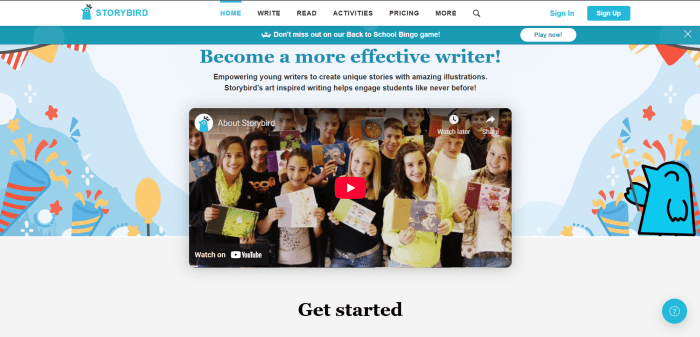
For writers who want to create age-appropriate children’s content with visual storytelling, StoryBird pairs your text with artwork to create complete picture book experiences. The platform understands the tone and vocabulary needed for different age groups.
StoryBird’s approach:
- Visual storytelling focus: Pairs your text with artwork to create complete picture book experiences
- Age-appropriate content: Understands tone and vocabulary for different age groups, from toddlers to middle-grade readers
- Publishing integration: Includes options to turn digital stories into physical books
- Series development: Helps create related stories with consistent characters and worlds
- Educational content: Supports both entertainment and educational storytelling
Children’s authors use it for brainstorming story concepts, developing character dialogue that sounds natural for kids, and creating series of related stories. Teachers and parents also use StoryBird to create personalized stories featuring their own children as characters.
Pricing starts at $4.99 monthly for individual creators. The investment makes sense if you’re serious about children’s writing, as specialized tools save significant revision time.
6. For Novel Writing – NovelistAI

For writers working on novels who need help maintaining world-building consistency across long projects, NovelistAI is your tool. The tool remembers character details and world rules from early chapters while you’re writing later ones.
Key features include:
- World-building consistency: Understands intricate details that make fantasy and sci-fi compelling
- Memory system: Remembers character details and world rules from chapter 1 while you’re writing chapter 15
- Genre expertise: Excels at adventure narratives where plot threads weave together over hundreds of pages
- Customizable interface: Adjust fonts, colors, and text size for accessibility
- Privacy focus: Your writing remains private and belongs to you
- Interactive elements: Support for choice-based interactive storytelling
Genre writers use NovelistAI for developing complex storylines, creating detailed character backstories, and exploring “what if” scenarios within their fictional worlds. The tool particularly excels at maintaining consistency across novel-length projects.
The main limitation is its focus on speculative fiction genres – literary fiction or contemporary stories might not benefit as much from its specialized features.
7. For Non-Fiction Writing – Jasper
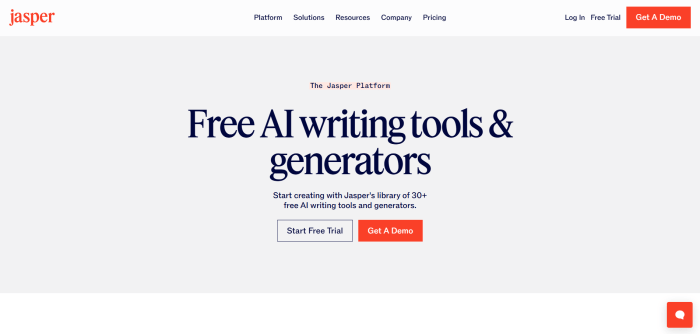
For bloggers who want to create engaging creative non-fiction content with proven structures, Jasper offers over 50 templates for different essay formats. The tool helps turn personal experiences into compelling blog posts that readers actually want to finish.
Jasper’s features for creative bloggers:
- Template variety: Over 50 templates covering everything from storytelling blog posts to creative product descriptions
- Format expertise: Understands different essay formats, from personal narratives to opinion pieces
- Anecdote expansion: Helps turn everyday experiences into engaging content readers want to finish
- Platform integration: Connects with WordPress and Medium for streamlined publishing
- Angle discovery: Suggests fresh perspectives on familiar topics
Creative bloggers use Jasper for developing article outlines, expanding on personal anecdotes, and finding fresh angles on familiar topics. You’re not starting from a blank page – you have proven frameworks that work.
Jasper’s pricing starts around $29 monthly for regular bloggers. Professional bloggers often make this back from a single sponsored post or affiliate commission.
The limitation is the cost, which might be steep for casual bloggers, and some templates can feel formulaic if not customized properly.
8. For Personal Writing – Day One
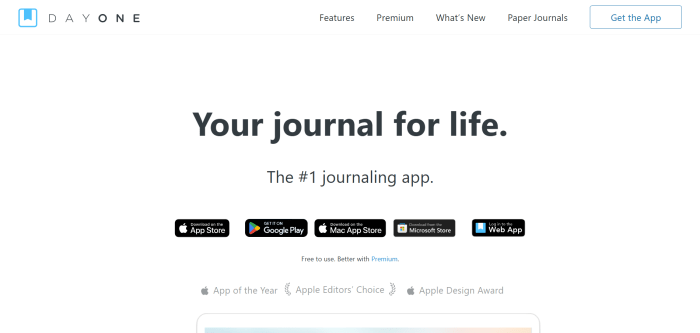
For writers who want to develop their personal stories and experiences into meaningful narratives, Day One transforms journaling into a creative practice. The tool uses AI-powered prompts to help you find compelling stories within everyday moments.
Day One’s approach to personal writing:
- Intelligent prompts: Instead of wondering what to write about, get guided questions like “What surprised you today?” or “Describe a moment that changed your perspective”
- Pattern recognition: AI suggests connections between different entries, helping spot recurring themes and character arcs in your life story
- Timeline visualization: See how your writing and thoughts have evolved over months or years
- Memoir development: Particularly valuable for writers working on personal narratives or memoirs
- Literature treatment: Treats personal writing as craft worth developing, not just diary entries
The basic version is free with essential features. Premium costs $2.92 monthly and adds advanced search, multiple photos per entry, and enhanced AI prompts.
Day One helps you find the story within your experiences, making everyday moments feel significant enough to explore creatively.
9. For Character Development – Character.AI

For writers who want to develop deeper, more authentic characters through interactive dialogue, Character.AI lets you have actual conversations with your fictional characters. You can test how they’d react in different situations and discover personality traits through direct interaction.
How Character.AI works:
- Interactive personas: Create character profiles and the AI embodies that personality, responding as they would in different situations
- Character consistency: Maintains personality traits across multiple interactions
- Scenario testing: Roleplay different situations to understand how characters would react
- Dialogue development: Test conversations and discover authentic character voices
- Motivation exploration: Ask characters directly about their goals and fears
Writers use this for character development in fascinating ways. Stuck on how your protagonist would react to conflict? Have a conversation with them. Need to understand your villain’s motivations? Ask them directly.
The basic experience is free. Character.AI+ costs $9.99 monthly for faster response times, priority access during busy periods, and early access to new features.
What makes writers obsessed with this approach is how it turns character creation from a planning exercise into exploration. You’re getting to know characters through genuine interaction, which often leads to more authentic dialogue and deeper character development.
10. For Editing and Proofreading – ProWritingAid
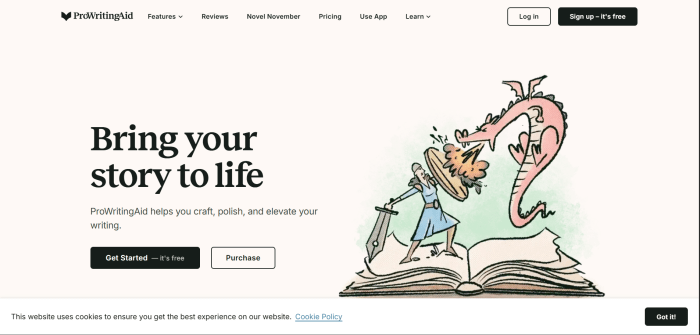
For writers who need more than basic spell-check and want to analyze their writing style specifically for creative work, ProWritingAid goes beyond grammar to catch things like repetitive sentence structures, overused words, and pacing issues that can make fiction feel choppy.
ProWritingAid’s creative writing features:
- Style analysis: Identifies repetitive sentence structures and suggests improvements for better flow
- Sensory report: Highlights where you might need more sensory details to make scenes come alive
- Overuse detection: Catches words and phrases you’re using too frequently
- Dialogue analysis: Reviews dialogue tags and suggests improvements for character voice
- Readability reports: Analyzes pacing and structure specific to creative writing
- Integration options: Works directly in Word, Google Docs, Scrivener, and other writing apps
- Real-time suggestions: Provides feedback without interrupting your writing flow
You can use ProWritingAid in whatever app you’re already writing in. The real-time suggestions don’t interrupt your flow, but they’re there when you’re ready to polish. The tool generates detailed reports on readability, dialogue effectiveness, and potential clichés.
The free version gives you basic grammar checking, but the premium subscription (around $79 per year) unlocks all the creative writing reports and integrations. The main drawback is that ProWritingAid can be overwhelming at first with all its suggestions – you’ll want to focus on one report at a time rather than trying to fix everything at once.
How to Choose the Right AI Creative Writing Tool?
Choosing the best AI writing tool for you should be a matter of aligning your particular creative requirements with what each tool is best at. Start by determining your main writing focus – it might be novels, poetry or even screenplays.
Consider your workflow preferences. Some writers prefer tools that produce entire sections, while others are looking for more subtle suggestions and nudges. Sudowrite is ideal for collective brainstorming, but Claude might be a better fit if you’re focusing on crafting already-there work.
Of course, budget is a concern, though don’t immediately go for the cheapest option. A more expensive tool that is perfectly suited to your writing style will always be a better companion.
Here’s a practical approach: You can try most tools or use them in joystick mode for free, or there are basic versions. Try 2-3 ones you feel seem the most promising for your genre. Keep in mind what feels best when you’re actually doing the writing, and not just setting up your environment.
And keep in mind: You’re not stuck with one tool forever. Many successful writers use different AI tools for different projects.

